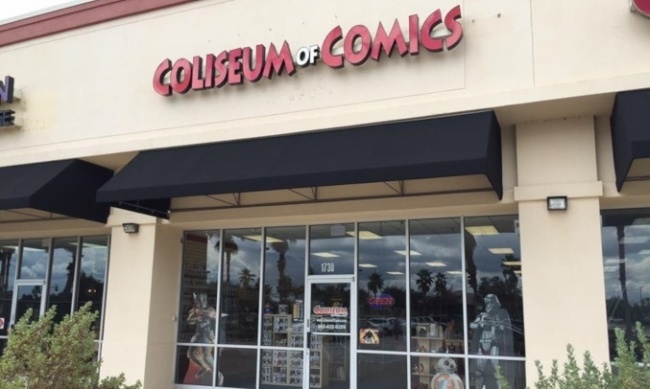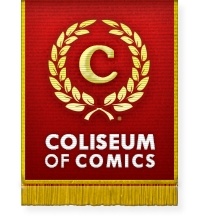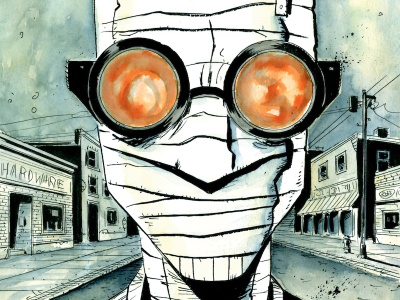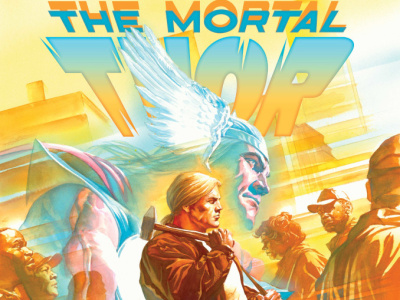Joe Field recently laid out some ongoing concerns for retailers that I agree wholeheartedly with. I have been doing my own analysis of sales over the last several months because, as Joe put it, something has to give. I’ve spoken to several publishers about these concerns and though they all seem to have a sympathetic ear when it comes to the plight of retailers, those fettered by large-corporation policy will likely not be able to change things without some major catalyst.
As a quick background, comic retailers are currently buying under a plan that, though tweaked over the years, is essentially the same buying structure that was put on the table by Phil Seulling 46 (FORTY-SIX!) years ago. As one of the supposed "Old Guard" at my august 35 years, even I wasn’t selling comics when this deal was struck. To add fuel to the fire that we’re mired in old policy, Diamond’s monthly printed discount terms are based on sales data from 2006! I don’t see this as a Diamond problem as much as a problem that no publisher wants to be the one to put their foot down and make the changes that need to be made. Fleecing the retailer base is wonderful for the bottom line until everyone can’t pay their bills anymore.
I understand the pressure that publishers have to make sure that the bank account is full at the end of each quarter. I get the whole variants adding to that bottom line and pricing structures are safe for publishers. I understand that Diamond has only the funds that their margin allows so all the wants of the retail side of things simply can’t happen. I also know that Steve Geppi has personally (he owns Diamond outright) buoyed many stores through difficult times. I get how all these moving parts work but I see the plight of retail stores going into 2019 as more than just Amazon and ennui when it comes to actually reading when video and Kindle are so available. Everyone likes to think we’re all partners in bringing comics to the masses. Here’s a truth: Despite the best intentions and love of comic by the folks at Marvel and DC, Disney and Warner Bros./AT&T are not comic fans beyond what it amounts to on the bottom line. But we need a change and not a small incremental thing; we need a complete sea change.
Per above, we need a catalyst as everything will continue like the proverbial frog in a warming pan of water. Here’s what I’m changing in 2019.
1. The Problem: 90% of the books coming off the stands at the end of their shelf life have zero value as a back issue. After 3 months, many books become box-fillers and dead items that take up space. No one is looking for a 3-issue mini-series 6 months removed unless it features a new character and there’s a rumor circulating about his/her inclusion in a movie that was possibly green-lit. Between February and October we had, at cost, nearly $100,000 in books that were taken off the stands. 60% were instantly unsellable. 30% will languish if they’re still here in 3 months.
My Solution: We’re looking at each title and any title that falls in that 90% range is slated for sellout. We used to order for backstock and still will on that 10%, but the rest are now on their own. This means we cut to obvious sales. We can chase higher sales but the diminishing profits to do so are no longer viable. I estimate this will put at minimum $20,000 in my pocket each quarter.
What Publishers Can Do: Returnability is only part of the solution. With every issue declining after #1, retailers cut their orders to keep ahead of the precipitous drops. WE can’t afford to put $2 cost into stocking one extra issue of everything in (fleeting) hopes of selling one more copy. It’s roulette and betting on black or red; one you win, the other you lose. So orders continue to drop and there’s no seeding copies on the stands. Here’s the pitch: Give us a declining match-to and then sell us anything above that for 50 cents. Yeah, I know the math. The first copy costs $10,000, the second and every copy thereafter is 15 to 22 cents. So meet us halfway and sell us seed copies. It removes the need for returnability, puts more books on the stands, and helps retailers with cashflow. Without this, the sliding sales scale toward zero is hastened and more titles get canceled.
2. The Problem: Reboots. No surprise but every jumping on point creates in its wake a jumping off point. There’s a greater concern though: continuity. No, not continuity of Spider-Man wearing a hat on page 3 when he had his head cut off on page 2, continuity of series collecting. This industry was built on reading and COLLECTING comics. When you reboot, what has gone before is no longer valid, which contributes to the 90% mentioned in Problem #1. With the prevalence of reboots, fan no longer feel invested as they know that nothing is any more permanent than the current creative team.
My Solution: Keep making excuses? That’s not really a solution, which is why this one is solely on the publishers.
What Publishers Can Do: Commit to at least a 5-year plan. Even if creative teams change, the numbers shouldn’t so that some continuity of series is in place.
3. The Problem: First issues. This is the most abusive part of comic ordering. Let’s define a "first issue" before I go on: Any issue ordered with no previous sales data for the title. If it’s weekly, every issue ordered before we have a week of sales data on #1 is a #1 for ordering purposes. If it’s a one-shot, it’s a #1. If it’s a #1, it’s a #1 (just clarifying on that one). Every #1 these days seems to be a double-sized or larger-then-normal size issue that adds a dollar or more to the #1 cover price, exacerbating retailers’ exposure.
My Solution: If it’s a weekly series, it’s predatory publishing and it gets subs-only orders. ZERO for the stands. Sell out? In 3 months, no one will remember it anyways. If it’s a horribly priced #1, we order to sell out; there will be a second printing if it’s that great a book. We’re done chasing incentives, we’d rather chase profits. On one-shots, we order subs and what we feel will be a guaranteed sell-out, which is what we think we might sell minus 20%. This goes for any second issue as well that we have to order before #1 hits the stands.
What Publishers Can Do: Set a reasonable number based on a similar book – which should not be 3X of one of the mega-crossover events. Anything above that, sell it to us at the aforementioned 50 cents. It would provide more sell-in and more copies of books on the stands. If we don’t have #1 then our chances of selling #2 fall to immeasurably low numbers.
4. The Problem: Special covers from issue to issue. This is predatory publishing. Fourteen covers on #1, 4 on #2, one of which is a Skottie Young variant, and one of which is a promotion-of-the-month cover. #3 has 1 cover but #4 has 3 covers again. This is an obvious ploy to keep retailers from gauging actual interest in the title and inevitably leads to unsold books on the stands. Without some degree of stability, we’re ordering blind.
My Solution: Ordering to sell out than ordering blind sounds much better from my financial end. I’ll be cutting to absolute sales levels. Before anyone cries that I’m being the maker of my own low-sales prophesy by cutting orders, let me assure you that each of my stores will continue to carry the iconic characters and books championed by staff. Most fans can’t afford to buy all the comics they want so removing the four-issue spin-off-barely sequitur-to-anything mini-series from their options will actually be a relief. I hate making fans think that they NEED to buy every nuanced tie-in when they can enjoy the books they read and are excited about without muddying that experience.
What Publishers Can Do: Cull the stand-filling minis. I know, bottom line and more immediate, bottom line RIGHT NOW. But you’re killing the market, which means bottom line tomorrow will be worse.
5. The Problem: Discounts. I have all the expected expenses for business. Labor is on the rise. Insurance costs have skyrocketed. After 7 years of double-digit growth, sales have been mostly flat over the last 2 years. Prices go up, but it just means fewer comics sold for more money. The math is, I can no longer allow publishers space at a 50%, non-returnable discount. The sales tail is too short, and the variables are too many to accurately gauge sell-through. I have 2000 dedicated fans of all things geeky coming through my doors a week. You get access to them, my smiling staff, my well-lit stores, and our reputation as a great comic store. I ’m paying a lot to provide that. You have your expenses, I have mine.
That Marvel can sell recent $4.99 books to Walmart that go 3 for $5 means that the cost of these books are substantially cheaper than what they could be sold to us for.
My Solution: Subs only on non-returnable books that are 50% or less discount. We have so many books to choose from now that I can literally cut 40% of titles and almost no one will notice. As breadth is a recipe for diminishing return, fewer can be better. Make me NEED to carry your product.
What Publishers Can Do: If you can’t exceed 50%, give me FREE incentive copies to make up for it. 1/5 – not even a special cover, same cover is fine/preferred! Buy 5, get one more free. If I’m buying non-returnable, the conversation needs to start at 60% with incentives for growing the market.
6. The Problem: Books without a market. If I’m selling less than 10 copies as a chain of 8 stores, then it’s subscription only. When carrying books of lower-sale titles, we only had a 73% sell-through over 6 months for a 30% profit. As such books are selling pretty much only to special orders, when a customer drops the title, we eat it.
My Solution: Subs only on low-sales titles. I’ll be raising this to 15 copies after the first quarter.
What Publishers Can Do: If a book is shipping and my customers don’t know about it before they come into the store then it’s just another book on the stands. Many creators do a wonderful job of sending customers after their work. Too many launch unknown. Promote! Give me an incentive to carry #2 as #1 is too often a speculator-driven sale. Do everything you can to keep a book from falling from that threshold and we’ll do the same on our end. Once it goes below 10 copies right now, we stop tracking it, which means it’s on death watch.
7. The Problem: Rushed and inconsistent scheduling. The publisher had delays so we don’t see a title for 2 months and then we see 3 issues in 5 weeks. This may help the publisher’s bottom line, but it destroys our sales tail and diminishes sales.
My Solution: When this pattern occurs, I’ll automatically assume the burn-out from over-exposure is going to cost us 10% of readers. I’ll be making those cuts at FOC.
What Publishers Can Do: If you’re late, suck it up. Don’t make us retailers pay for your problem.
8. The Problem: Promo Items. I love nice promo items. Customers love them to some degree but even the nicest postcard is often found in the trash can right outside the store. Customers are overwhelmed with advertisements. Some look for those that target them and react. The problem is, publishers have a broad-brush promotional item and then want to sell it to us.
My Solution: Nope. Not paying for your promotions. You’re selling us non-returnable product with limited information and then you want to charge us to promote it? Nuh-uh. Not happening. Send us the promo items at no cost and IF it’s going to raise my sales, I might give you free counter space or free labor to bag-stuff them.
What Publishers Can Do: When I opened Coliseum of Comics, I did it on my own dime and didn’t realize a profit for several years. Publishers seem to want to put out a new comic to instant profit. This is a broad-brush statement but we’re talking about broad-brush promos. Give us a minor co-op budget to print our own fliers. Co-op can take the form of funds, added discounts, or added product.
So let’s face it, we’re not exactly partners. But we’re all sitting at the same buffet but the crumbs at the retail end of the table seem to be dwindling. We need to be partners. Some could survive via online and mail-order but far too many people would lose their livelihood if another 500 stores close; there’s a point where the systems in place cannot be sustained by the surviving entities.
I have 12 years of new comics sales data, but I look at last issue when ordering comics as there is no pattern to the freefall. If this doesn’t disturb you, it should. I am a single voice but I’m not alone in my concerns.
The opinions expressed in this column are solely those of the writer, and do not necessarily reflect the views of the editorial staff of ICv2.com.









